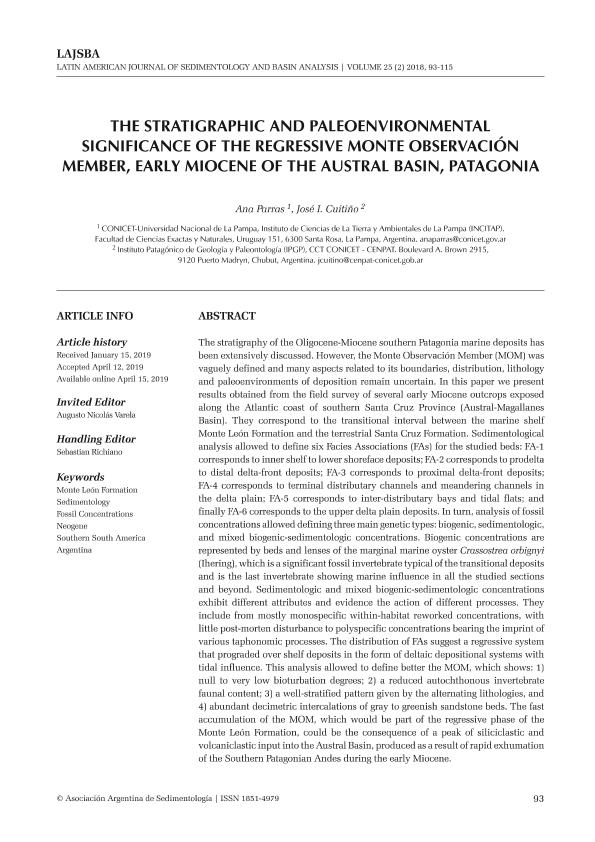Mostrar el registro sencillo del ítem
dc.contributor.author
Parras, Ana Maria

dc.contributor.author
Cuitiño, José Ignacio

dc.date.available
2019-10-22T17:22:52Z
dc.date.issued
2018-12
dc.identifier.citation
Parras, Ana Maria; Cuitiño, José Ignacio; The stratigraphic and paleoenvironmental significance of the regressive Monte Observación Member, Early Miocene of the Austral Basin, Patagonia; Asociación Argentina de Sedimentología; Latin American Journal of Sedimentology and Basin Analysis; 25; 2; 12-2018; 93-115
dc.identifier.issn
1851-4979
dc.identifier.uri
http://hdl.handle.net/11336/86904
dc.description.abstract
The stratigraphy of the Oligocene-Miocene southern Patagonia marine deposits has been extensively discussed. However, the Monte Observación Member (MOM) was vaguely defined and many aspects related to its boundaries, distribution, lithology and paleoenvironments of deposition remain uncertain. In this paper we present results obtained from the field survey of several early Miocene outcrops exposed along the Atlantic coast of southern Santa Cruz Province (Austral-Magallanes Basin). They correspond to the transitional interval between the marine shelf Monte León Formation and the terrestrial Santa Cruz Formation. Sedimentological analysis allowed to define six Facies Associations (FAs) for the studied beds: FA-1 corresponds to inner shelf to lower shoreface deposits; FA-2 corresponds to prodelta to distal delta-front deposits; FA-3 corresponds to proximal delta-front deposits; FA-4 corresponds to terminal distributary channels and meandering channels in the delta plain; FA-5 corresponds to inter-distributary bays and tidal flats; and finally FA-6 corresponds to the upper delta plain deposits. In turn, analysis of fossil concentrations allowed defining three main genetic types: biogenic, sedimentologic, and mixed biogenic-sedimentologic concentrations. Biogenic concentrations are represented by beds and lenses of the marginal marine oyster Crassostrea orbignyi (Ihering), which is a significant fossil invertebrate typical of the transitional deposits and is the last invertebrate showing marine influence in all the studied sections and beyond. Sedimentologic and mixed biogenic-sedimentologic concentrations exhibit different attributes and evidence the action of different processes. They include from mostly monospecific within-habitat reworked concentrations, with little post-morten disturbance to polyspecific concentrations bearing the imprint of various taphonomic processes. The distribution of FAs suggest a regressive system that prograded over shelf deposits in the form of deltaic depositional systems with tidal influence. This analysis allowed to define better the MOM, which shows: 1) null to very low bioturbation degrees; 2) a reduced autochthonous invertebrate faunal content; 3) a well-stratified pattern given by the alternating lithologies, and 4) abundant decimetric intercalations of gray to greenish sandstone beds. The fast accumulation of the MOM, which would be part of the regressive phase of the Monte León Formation, could be the consequence of a peak of siliciclastic and volcaniclastic input into the Austral Basin, produced as a result of rapid exhumation of the Southern Patagonian Andes during the early Miocene.
dc.format
application/pdf
dc.language.iso
eng
dc.publisher
Asociación Argentina de Sedimentología
dc.rights
info:eu-repo/semantics/openAccess
dc.rights.uri
https://creativecommons.org/licenses/by-nc-sa/2.5/ar/
dc.subject
MONTE LEÓN FORMATION
dc.subject
SEDIMENTOLOGY
dc.subject
FOSSIL CONCENTRATIONS
dc.subject
NEOGENE
dc.subject
SOUTHERN SOUTH AMERICA
dc.subject
ARGENTINA
dc.subject.classification
Geología

dc.subject.classification
Ciencias de la Tierra y relacionadas con el Medio Ambiente

dc.subject.classification
CIENCIAS NATURALES Y EXACTAS

dc.title
The stratigraphic and paleoenvironmental significance of the regressive Monte Observación Member, Early Miocene of the Austral Basin, Patagonia
dc.type
info:eu-repo/semantics/article
dc.type
info:ar-repo/semantics/artículo
dc.type
info:eu-repo/semantics/publishedVersion
dc.date.updated
2019-10-10T13:18:05Z
dc.journal.volume
25
dc.journal.number
2
dc.journal.pagination
93-115
dc.journal.pais
Argentina

dc.journal.ciudad
Ciudad Autónoma de Buenos Aires
dc.description.fil
Fil: Parras, Ana Maria. Consejo Nacional de Investigaciones Científicas y Técnicas. Instituto de Ciencias de la Tierra y Ambientales de La Pampa. Universidad Nacional de La Pampa. Facultad de Ciencias Exactas y Naturales. Instituto de Ciencias de la Tierra y Ambientales de La Pampa; Argentina
dc.description.fil
Fil: Cuitiño, José Ignacio. Consejo Nacional de Investigaciones Científicas y Técnicas. Centro Científico Tecnológico Conicet - Centro Nacional Patagónico. Instituto Patagónico de Geología y Paleontología; Argentina
dc.journal.title
Latin American Journal of Sedimentology and Basin Analysis
dc.relation.alternativeid
info:eu-repo/semantics/altIdentifier/url/http://ppct.caicyt.gov.ar/index.php/lajsba/article/view/14645
Archivos asociados
